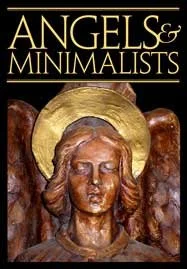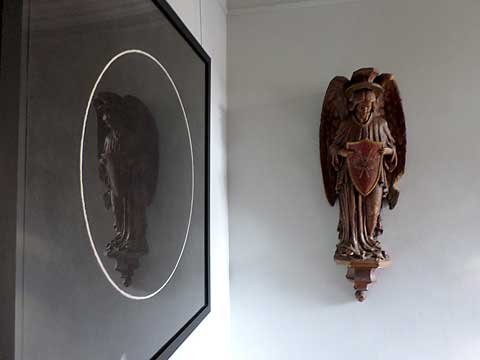Angels & Minimalists
December 23, 2013 – January 31, 2014
THE ANGEL OF ALBANY came to us unexpectedly. Angels are usually a surprise when they appear and this one was no different. We first saw him lying in the back of a red pickup truck. We noticed he held a shield depicting a crown of thorns and 2 spears. There are nine celestial orders of Angels and those who hold shields are of the second order. They draw from God’s power to work miracles on earth. Among their tasks, they help those who struggle with their faith. We don’t know if the Angel of Albany came to us with that particular purpose, but he has inspired this years holiday installation nonetheless.
The annual Curious Matter holiday installation incorporates Catholic traditions and icons. We do this not as an articulation of faith in church doctrine per se, but rather in celebration of the communal goodwill we all, regardless of faith, call upon during these long, cold nights of winter. For us, goodwill is irrevocably linked to the teaching, ritual, and aesthetic of the Catholic Church. While our adult opinions of the institutional church may have gained some critical aspect, the understanding and acceptance of the purity of intention learned in childhood remains.
Our past installations have included hand-stitched embroidery Sacred Hearts (Petite Voie), mass-produced lithographs from the 1800s depicting the Ten Commandments and scenes from the life of Christ (Our Father and the Tiny Guardian), also found objects engaged as symbols of the season (The Relic of 41st Street). All of these were small, intimately scaled devotions. What makes this year’s installation unique is how large it is.
The Angel of Albany is cast in plaster and stands nearly 4 feet tall. It was a gift to Curious Matter from co-founder Arthur Bruso’s family and delivered unannounced by his brother Michael. Like most of the religious castoffs we’ve collected its provenance is unknown. The Bruso’s had gotten it from a contractor who claimed no knowledge of its original home. We suspect it resided in a church in or around Albany, New York. Our current best guess is that it is a Gothic Revival, or Arts and Crafts piece (this would date it c. 1900) from a church whose congregation dwindled and departed; the house of worship deconsecrated, its ornament dismantled and disbursed. The angel was probably one among many in its original setting. (Arthur’s brother George has a matching one.) Still, hanging solo in our gallery, it exudes a particular grandeur.
We sometimes ponder why, with such a passion for the ornament found in churches and cathedrals, we don’t work within that tradition. That’s a fleeting thought. The appreciation of medieval art through to the Renaissance isn’t erased with the thrust of our own or any contemporary artwork. Traditional Christian iconography and the minimalist or post-minimalist vocabulary might seem visually disparate, but we don’t see them as lacking common ground. With that, we’re presenting the Angel of Albany alongside a work by Raymond E. Mingst. His is a charcoal on paper drawing that measures approximately 4 feet square, a simple mandala. The installation brings these works together as an opportunity to read them with an eye towards retaining spiritual possibilities as a valid interpretation of contemporary artwork.
Both the angel and the mandala are objects of contemplation and meditation. The angel is a messenger, a guardian; he brings us the word of the spirit and guides us towards the righteous path. The mandala is an opening to the voice of the spirit. The angel stands at the throne of the divine and guards the spirit from evil. He is the light that surrounds the holy and as such, a nimbus personified. The mandala may be used to generate a protective space. It is a symbol of positive, surrounding light. Both angel and mandala offer a visual pathway to the divine.
We return to Christian icons in part because the mythology is reassuringly identifiable while transformatively spiritual. Anne Truitt, Mark Rothko and Felix Gonzalez-Torres, to name just a few artists working with a minimalist vocabulary, produce contemplative artworks that also evoke spirituality. Whether we’re sitting in Rothko Chapel or considering the geometry of Piero della Francesca, there are aspects to these works beyond our ability to name. We use the term spiritual to signify that unknowable, unnameable quality which we find so transcendent.
In celebration of the holidays we offer the Angel of Albany and R. E. Mingst’s mandala as points of contemplation and symbols of the light of the season. Regardless of the vocabulary we call upon to articulate that which we find most significant and worthy, during this time of year, we invite you to join us and embrace the divine in all of it.
Warmest good wishes.
Installation view: left, Untitled, (Mandala, remnant), 2003, by Raymond E. Mingst, 42 X 42 inches, right, The Angel of Albany, c. 1900, painted plaster, approx. 20 X 53 inches.


